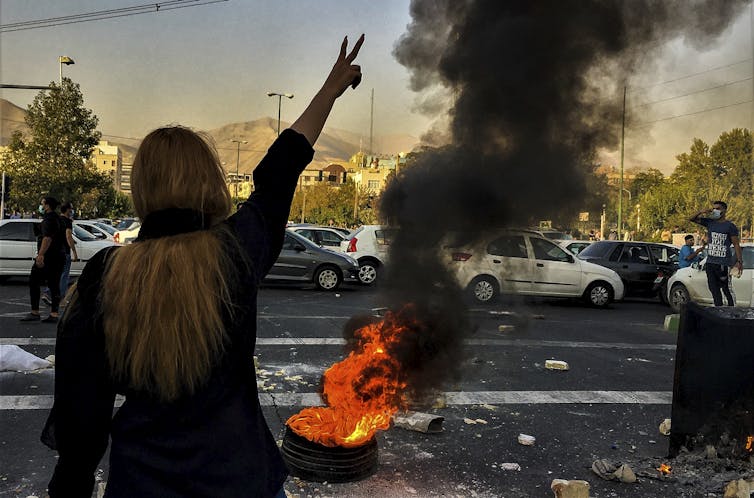Detta inlägg post publicerades ursprungligen på denna sida this site ;
Date:
Author: Mina Fakhravar, PhD Candidate, Feminist and Gender Studies, L’Université d’Ottawa/University of Ottawa
Original article: https://theconversation.com/how-irans-government-has-weaponized-sexual-violence-against-women-who-dare-to-resist-253791
In Iran’s 2022–2023 “Woman, Life, Freedom” uprising, women’s bodies quite literally became battlefields.
The protest movement erupted after the death in custody of 22-year-old Mahsa (Jina) Amini, who was arrested by Iran’s morality police for improperly wearing a hijab.
Her death became a powerful symbol of the government’s patriarchal control over women’s bodies, and ignited protests that exposed the regime’s use of sexual violence as a weapon of repression.
Testimonies from survivors, shared despite stigma and fear, revealed harrowing abuses: women protesters were beaten, sexually assaulted, raped (including gang rape and rape with objects), stripped naked and tortured during their arrests, transfers and detention in both official and unofficial sites, and throughout interrogations.
These were not isolated acts but calculated techniques to punish dissent and instil terror.

(AP Photo/Middle East Images)
Marking, punishing, controlling women
One of the most chilling testimonies belongs to a young woman detained during the protests:
“My friends and I removed our veils in public and we were chanting. The thought never crossed my mind that the security forces would arrest us… From the moment we were arrested, they beat us violently… They told us ‘There is no God here. We are your God.’”
She was later subjected to a violent gang rape.
The Iranian government apparently views women’s bodies as territories to be marked, disciplined and punished. Its patriarchal ideology reduces women to bearers of family honour and religious purity, legitimizing state control over their appearance, behaviour and movement.
As French materialist feminist Colette Guillaumin theorized with the concept of “sexage”, patriarchal systems reduce women to “natural objects” — beings whose bodies, time and sexuality are appropriated and controlled. Nicole-Claude Mathieu further underlined how this appropriation operates across diverse contexts of domination.
In Iran, these insights help explain how the state instrumentalizes women’s bodies as symbols of ideological domination and as resources to be regulated and exploited. Forcibly veiling or unveiling women, as Guillaumin argued, signifies public ownership over their bodies, transforming their visibility and autonomy into objects of state control.
The politics of sexual violence
The Iranian state seemingly perceives unveiled women not merely as disobedient citizens but as bodies that have escaped control and refused their assigned status of possession.
For this transgression, punishment seeks to annihilate them: through humiliation, torture and rape. Media reports have indicate that security forces have deliberately targeted female protesters’ eyes and genitals, further exemplifying how women are reduced to mere sexual and reproductive objects.
This targeted violence exposes how, in the eyes of the authorities, women’s identities are crudely reduced to their faces and genitals, symbols of their visibility and sexuality.
Far from isolated acts, rapes and sexual violence committed by Iranian state forces during the “Woman, Life, Freedom” uprising embody what feminist scholar Catharine MacKinnon defines as a “system of sexual terrorism”, where sexual violence is neither private nor incidental but a methodical instrument of political domination.
Rape allows the authorities to discipline women who have dissented, to humiliate them and to reassert control over those who dared reclaim their bodies and voices.
Stigma, silence and legal abandonment
But sexual violence never ends with the act itself. Its aftermath carves deep and lasting scars in survivors’ lives.
In Iran, rape survivors endure not only trauma but also social exclusion, stigma and judicial abandonment. The Iranian legal system, which narrowly defines rape under “zina” (fornication), often punishes the victim if she cannot produce four male witnesses. This often silences survivors.
As another survivor, interviewed by Amnesty International, declared:
“I will never be the same person again… But I hope that my testimony will result in justice, and not just for me … so maybe we can prevent similar bitter events from happening again in the future.”
The Iranian government’s obsession with controlling women extends beyond their bodies to systems of surveillance. In 2025, Tehran authorities have deployed 15,000 new AI-powered surveillance cameras, alongside drones and facial recognition technologies, explicitly to enforce compulsory hijab laws.
In Iran, veiling is not only religious but profoundly political, a public sign of submission to patriarchal rule.
Meanwhile, executions in Iran have surged to alarming levels, with at least 972 people executed in 2024 alone, the highest in eight years. Among those targeted are women activists, particularly from ethnic minority groups, facing death sentences for their resistance.
The 2025 report by the United Nation’s Fact-Finding Mission highlights the ongoing cases of Pakhshan Azizi, Sharifeh Mohammadi and Varisheh Moradi, all sentenced to death.
Their cases, alongside Iran’s skyrocketing execution rate, expose a terrifying pattern of state femicide: the execution of women who dare to fight for gender justice and human rights.
Global responsibility
These are not domestic Iranian matters — they are crimes against humanity.
As MacKinnon reminds us, sexual violence is not private, it is a political weapon and a civil rights violation. The world must act by imposing targeted sanctions on perpetrators, offering asylum to survivors and supporting Iranian feminist movements demanding justice.
To let these crimes go unanswered is to surrender women’s bodies to impunity. Iranian women have shown extraordinary courage. The global response must match their bravery with action.
![]()
Mina Fakhravar does not work for, consult, own shares in or receive funding from any company or organisation that would benefit from this article, and has disclosed no relevant affiliations beyond their academic appointment.

